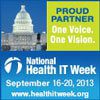CNSI Attends University of Maryland’s WHITE 2013 Conference
![]() Earlier this month, the University of Maryland’s prestigious Robert H.
Earlier this month, the University of Maryland’s prestigious Robert H.
 Earlier this month, the University of Maryland’s prestigious Robert H. Smith School of Business held its 4th annual Workshop on Health IT and Economics.
Earlier this month, the University of Maryland’s prestigious Robert H. Smith School of Business held its 4th annual Workshop on Health IT and Economics.
CNSI was proud to sponsor the event, which brought together academic and private sector leaders in health IT from around the country to present insightful commentary on the opportunities and challenges faced by the industry.
The two day conference took place in Washington, D.C. and highlighted cutting-edge research from the likes of the University of Texas Health Science Center, the University of Pennsylvania Health System, Children’s National Medical Care and the U.S. Department of Health & Human Services.
Of the many health IT topics discussed, social media stood out as a still untapped industry resource. Discussing its potentials, Harvard Business School Assistant Professor Michael Luca presented his findings on ‘Digitizing Disclosure,’ that is, utilizing social platforms to disseminate information regarding public health warnings. Would a Yelp review or Facebook notification be a more apt warning than a physical posting on a door?
According to Prof. Luca, we may some ways go. However, as these technologies become more ubiquitous, leveraging themselves into even more aspects of our everyday lives, the proof is yet to come.
Greg Kruse of the University of Pennsylvania Health System shared similar sentiments when it comes to the power of the communication tools at our disposal. In his keynote address on day one of the conference, Mr. Kruse stated that broader communication strategies will build new relationships between doctors and patients.
Mr. Kruse surely has a point. As we continue to advance health IT solutions we are not only building cost-effective efficiencies for the management of care, but influencing the very nature of how we receive, interpret, and communicate with our health care providers and communities.
How can health IT improve the way you interact with your physician or community? Tweet @CNSICorp to let us know! Follow CNSI on Twitter.
 While advances in technology allow us to store important health information on the cloud and within our mobile applications, CNSI and organizations like ours have the added requirement to always ensure privacy and security when it comes to holding confidential data.
While advances in technology allow us to store important health information on the cloud and within our mobile applications, CNSI and organizations like ours have the added requirement to always ensure privacy and security when it comes to holding confidential data. While advances in technology allow us to store important health information on the cloud and within our mobile applications, CNSI and organizations like ours have the added requirement to always ensure privacy and security when it comes to holding confidential data. To address concerns regarding the security of a patient’s personal information, certain standards have been implemented that require providers to comply with privacy standards.
While advances in technology allow us to store important health information on the cloud and within our mobile applications, CNSI and organizations like ours have the added requirement to always ensure privacy and security when it comes to holding confidential data. To address concerns regarding the security of a patient’s personal information, certain standards have been implemented that require providers to comply with privacy standards.
 National Healthcare Quality Week, supported by the
National Healthcare Quality Week, supported by the  National Healthcare Quality Week, supported by the
National Healthcare Quality Week, supported by the  In addition to the launch of open enrollment for the
In addition to the launch of open enrollment for the  In addition to the launch of open enrollment for the
In addition to the launch of open enrollment for the  October 1st marks the first open enrollment date for the Affordable Care Act (
October 1st marks the first open enrollment date for the Affordable Care Act ( October 1st marks the first open enrollment date for the Affordable Care Act (
October 1st marks the first open enrollment date for the Affordable Care Act ( National Health IT Week wrapped up last week with events across the country focusing on how cloud-based solutions, data management and technology, mobile applications and patient engagement systems are improving and changing the ways we manage our healthcare.
National Health IT Week wrapped up last week with events across the country focusing on how cloud-based solutions, data management and technology, mobile applications and patient engagement systems are improving and changing the ways we manage our healthcare. National Health IT Week wrapped up last week with events across the country focusing on how cloud-based solutions, data management and technology, mobile applications and patient engagement systems are improving and changing the ways we manage our healthcare. Doctors, administrators and legislators were on hand, participating in events that highlighted technology’s place and potential in healthcare.
National Health IT Week wrapped up last week with events across the country focusing on how cloud-based solutions, data management and technology, mobile applications and patient engagement systems are improving and changing the ways we manage our healthcare. Doctors, administrators and legislators were on hand, participating in events that highlighted technology’s place and potential in healthcare.

